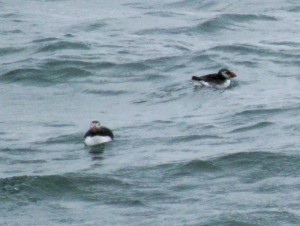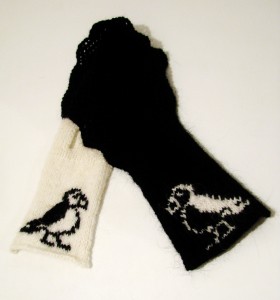Knit a puffin. Posted by hulda on Jul 25, 2012 in Icelandic culture, Icelandic customs
 Things are not always black and white, not even if you’re a puffin. Quite the contraty in fact – there are many possible colours for puffins and Icelandic has a specific name for each type.
Things are not always black and white, not even if you’re a puffin. Quite the contraty in fact – there are many possible colours for puffins and Icelandic has a specific name for each type.
The pufflings, pysja (also known as pésja, kofa and lundungi), are almost like adult puffins in colour by the time they leave the burrows except for their grey-black face. For some puffins the face stays dark throughout their life and this colour variation goes by the names kolapiltur (= coal boy) and sótari (= chimney sweep). To define whether a puffin is an adult or not, look at the size and colour of its beak. A puffling’s beak is a lot smaller and usually black, an adult’s is large and multicoloured during the mating season.
A completely white puffin, albínói (= albino) is called kóngur (= king). If the usually black areas are brown instead, the puffin’s called drottning (= queen) and an otherwise normal but speckled or dotted puffin is a prins (= prince).
The variations on the looks of the Atlantic puffin don’t end there – some of them can even have tufts on their head! For those interested, there are some photo examples of how these unusual puffins look like here and here.
Then for some sad news. The little puffling of the burrow cam that I linked in the previous puffin entry did not make it. The reason for its death was malnourishment: there were not enough small fish around so the parents carried in fish that were far too large for the puffling to swallow. Sad as it is, that’s just the way things happen sometimes, and a fact is that a large amount of pufflings die every year long before they’re old enough to leave the nest.
Personally I took this bit of news in a very calm, adult-like manner and anyone telling you stories of me getting teary-eyed because of a small, cute, fluffy bird that was apparently named Petey is a naughty, naughty liar. Ahem. I mean admittedly I knitted this scarf to better get over my many feelings regarding the issue but I did that because I’m a tough guy, I don’t cry (I DIDN’T, HONEST*), I knit.
If you’d also like to try your hand at knitting, the pattern for this scarf can be found here.
For those of you who’d rather knit after other patterns that are written in Icelandic instead, here’s a small vocabulary list to help you begin!
Fitja/fitjið upp = cast on
Fella/fellið af = bind off / cast off
Prjóna/prj = to knit: often used to mean stocking stitch
Sléttar lykkjur/sl = knit
Brugðnar lykkjur/br = purl
Garðaprjón/slétt prjón = garter stitch
Perluprjón = moss stitch (lit. transl. “pearl stitch”)
Munstur = pattern
Auka/aukið út = increase
Taka/takið úr = decrease
Setja/setjið saman = join
Slá/sláið uppá = yarn over
Snúa/snúið við = to turn the work over
Hnappagöt = button hole
Hnappar = buttons
Hjálparprjónn = cable needle (lit. transl. “helping needle”)
Hringprjónn = circular needle
Sokkaprjónn = double pointed needle (lit. transl. “sock needle”)
Fjöldi umferða = number of rows
Ull = wool
Garn = yarn
*Personally I would never trust a person who feels the need to add “honest” to the end of a sentence. It sounds like they’re trying to hide something.

Build vocabulary, practice pronunciation, and more with Transparent Language Online. Available anytime, anywhere, on any device.
About the Author: hulda
Hi, I'm Hulda, originally Finnish but now living in the suburbs of Reykjavík. I'm here to help you in any way I can if you're considering learning Icelandic. Nice to meet you!




